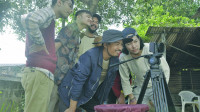Entertainment
Home away from home
The break-away Nepali music sensation Bipul Chettri performed for a sold-out crowd at the Melrose Ballroom in New York, USA over the weekend in an event where he was also joined by other Nepali luminaries
The break-away Nepali music sensation Bipul Chettri performed for a sold-out crowd at the Melrose Ballroom in New York, USA over the weekend in an event where he was also joined by other Nepali luminaries including the designing icon Prabal Gurung, actor Priyanka Karki, Diwas Gurung and Prasan Syangden. With the concert that ran into the wee hours of Saturday, Chettri joins a long list of Nepali artists travelling to cities abroad to play for the ever-growing Nepali diaspora.
In the past year alone, A-lister Nepali artists like Nepathya, 1974 AD, Albatross and the Maha Jodi have all toured various cities in the US. On April 26, 2015, 1974 AD’s new line-up were due to play at the University of Colorado in Boulder, Colorado when the news of the April 25 earthquake stated filtering in. The band, who were in Boulder at the request of the Nepal Student Association at the university, had converted the show into a fundraiser for the relief efforts. In September, the evergreen Maha Jodi and their troupe visited dozens of cities in the US and Canada on a whirlwind month-long tour. Earlier this year, the Nepali rock outfit Albatross also became the first Nepali band to perform at the prestigious South by South West (SXSW) music and film festival in Texas, USA as part of their tour of the American south-west.
Speaking to the Post, Kiran Krishna Shrestha, the publicist for the folk-rock band Nepathya, confirmed that with the number of the Nepali diaspora growing, it is becoming more and more feasible for Nepali artists and their entourage to play for respectable crowds abroad. “Though Nepali artists have been playing to crowds abroad for a while, it has been good to see that organisers are now willing to meet the technical requirements of the performing band and ensuring that the whole entourage travels to shows rather than just the lead singer,” he said. Nepathya recently returned from a two-legged tour to the US, where they played for a capacity crowd in Los Angeles before headlining the annual conference of the Association of Nepalis in the Americas (ANA) in Atlanta, US. Shrestha, however, warns that it is important these burgeoning shows remain technically sound and well-organised so that the audience get a bang for their buck. “At the end of the day, regardless of where the band is performing, it has to be insured that quality shows are being put together, or else travelling the world for concerts will not help the Nepali music industry grow.”
The number of Nepali migrants and second-generation Nepalis has been on the steady rise in the USA. As of 2010, there were 300,490 Americans who identified themselves as Nepali American—an ethnic group only recognised in 1974 (with 56 Nepali Americans at the time). The number does not include Nepali students studying in the US. American states like Texas, Virginia and California remain popular with touring artists for the high concentration of Nepalis there. New York, however, with 7,625 Nepalis (in 2010) is the biggest hub for Nepalis and the most popular stop-over for Nepali artists.
Sujan Dev Bhandari, who in jest identifies himself as a part-New Yorker, was at the Chettri concert on Saturday and described the show as an “absolute blast.” According to his estimates there were well over a 1000 people at the show and after party. “It is really great to be able to be a part of the growing Nepali music industry even though we are home away from home,” he said, “Events like these not just satiate the Nepali diaspora’s natural longing for home but also brings together the Nepali community. I just ran into an old friend I did not even know was living in the US at the show.”




 8.39°C Kathmandu
8.39°C Kathmandu









